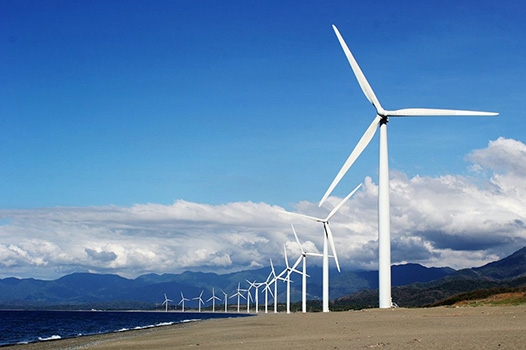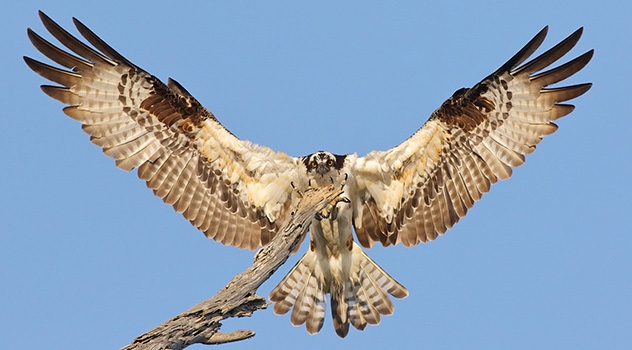Wind energy is a crucial solution for combating climate change, yet it is not without controversy. From altering landscapes to the construction of new power grids, wind farms are often met with resistance due to “Not In My Backyard” (NIMBY) objections. Beyond aesthetic concerns, a more ecologically significant issue arises: the threat wind farms pose to wildlife, particularly bats and birds.
As biodiversity loss intensifies globally, protecting natural ecosystems has become a central concern. Fortunately, through scientific research and innovative technology, we can identify these problems and implement effective, cost-efficient solutions. Today, Inverter.com will explore the impact of wind turbines on bats and birds and the measures we can take to mitigate their effects.

The Threat of Wind Turbines to Bats
Bats are vital components of ecosystems, serving as key pollinators and natural pest controllers. However, the harm wind turbines inflict on bats is more severe than many realize. In North America alone, wind farms kill 600,000 to 900,000 bats annually. These deaths primarily result from two causes:
- Direct Collision: Bats flying near wind turbines are often struck by rapidly rotating blades, posing an immediate and fatal danger.
- Barotrauma: Wind turbines create significant pressure changes in the surrounding air. When bats venture too close, the sudden pressure drop can cause severe internal injuries or organ rupture.
Studies have shown that adjusting the cut-in speed of wind turbines can significantly reduce bat fatalities. Typically, turbines start operating when wind speeds reach 3 meters per second (a light breeze). Research suggests that raising this threshold to 6 meters per second could greatly decrease bat mortality rates. Possible explanations include:
- Altered Bat Behavior: Many bats rely on low-wind environments to hunt for insects. Higher wind speeds reduce insect activity, which in turn discourages bats from flying in the area.
- Avoidance of Hazardous Conditions: Bats tend to avoid areas with strong winds, reducing the likelihood of collisions.
The financial cost of this adjustment is minimal. Estimates indicate that the annual energy loss from raising the cut-in speed would be just 1%. From a biodiversity perspective, this is a small price to pay.
Smart Curtailment Technologies: European Union regulations already mandate wind farm operation limits during peak bat activity periods, such as migration seasons when low wind speeds and mild temperatures coincide. Emerging technologies, such as intelligent curtailment systems, can dynamically adjust turbine operations based on local bat activity, temperature, and wind speeds. These systems strike a balance between conserving bats and minimizing energy losses.
The Threat of Wind Turbines to Birds
Compared to bats, bird fatalities from wind turbines are more visible, particularly among large raptors such as vultures. In regions like Africa and Southern Europe, wind farms have become stealthy killers of vultures. While these birds possess extraordinary vision to locate carrion from the air, they often fail to detect nearby wind turbines. This vulnerability stems from their unique blind spots.
- Vultures’ Blind Spots and the Risk They Pose: Research has revealed that vultures cannot see directly in front of them while flying, due to an evolutionary adaptation that prevents glare from sunlight. While this trait was advantageous in natural environments, it has become a liability in the presence of tall, rotating human-made structures.
- Selective Shutdowns: For large raptors, the most effective collision prevention method is selective shutdown. A study of 13 wind farms in Spain demonstrated that temporarily halting turbines when birds were nearby reduced fatalities by 50%, while annual energy production loss was a mere 0.07%. This approach has also been successfully implemented at Kenya’s Kipeto Wind Farm, which is located near a significant population of endangered Rüppell’s vultures. In 2022, turbine shutdowns related to bird conservation accounted for just 0.014% of the site’s projected annual energy output—an impressively low figure.
Other bird species, such as white-tailed eagles, are similarly at risk of wind turbine collisions. Researchers have proposed straightforward yet effective solutions, such as painting turbine blades. A 2020 study in Norway revealed that painting a single-blade black reduced bird fatality by 70%. Scientists believe the contrasting color enhances the visibility of the blades, enabling birds to recognize and avoid them.
Currently, other regions are also testing similar improvements, including blades with striped designs and more vibrant coating options. Similarly, the Home Power Inverter also sells vertical axis wind turbines in a red, blue, and white integrated color scheme. These small adjustments are both cost-effective and play an important role in bird conservation.

Broader Considerations: Balancing Green Energy and Ecosystem Protection
The expansion of wind energy is a cornerstone of the global green energy transition. However, its potential ecological impact cannot be overlooked. While the risks to bats and birds have garnered attention, the effects on other wildlife, such as insects, remain underexplored. Questions about how large-scale turbine operations might alter insect migration patterns and disrupt ecosystems warrant further investigation.
Future Directions in Technology
Technological advancements offer numerous opportunities to better harmonize wind energy development with wildlife conservation, including:
- Radar Monitoring Systems: Real-time tracking of bird and bat flight paths can provide early warnings and allow turbines to adjust dynamically.
- Optimized Site Selection: Strategic planning of wind farm locations can prioritize areas with lower wildlife activity.
- Multidisciplinary Collaboration: Integrating the expertise of ecologists, engineers, and policymakers can foster the development of proactive and sustainable energy strategies.
- The Importance of Public Engagement: Public acceptance of green energy projects is closely tied to visible wildlife protection efforts. By demonstrating a commitment to minimizing harm to wildlife, wind energy developers can gain broader public support, ultimately accelerating the adoption of renewable energy.
Conclusion
The impact of wind turbines on bats and birds is a genuine concern, but it is far from an unsolvable problem. Measures such as increasing cut-in speeds, implementing selective shutdowns, and making simple design changes like painting turbine blades have been shown to significantly reduce wildlife fatalities. With continued technological innovation and deeper integration of conservation principles, we can achieve a win-win scenario where renewable energy development and biodiversity protection go hand in hand.
As we advance along the path of energy transition, the growth of wind energy is inevitable. However, every step forward must be guided by a profound respect for nature and a commitment to safeguarding all forms of life.
